Featured image: Creative Commons Licence by jomelia
As Steve Howe gets ready to embark on Yes’ 50th Anniversary UK tour of the seminal album Close to the Edge, we sat down with the prog pioneer to discuss his long-standing love of Gibson hollowbody guitars, Line 6 modelling, and behind the scenes studio techniques used to capture the magic of the early Yes records…
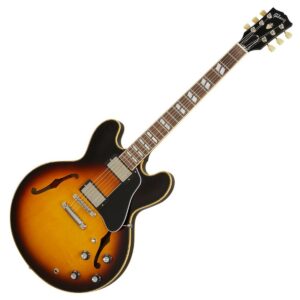 Gear4music: For Close to the Edge (1972), you used a Gibson ES-345. What’s the story of that guitar, and was there a particular reason you preferred it to your iconic ES-175 for that album?
Gear4music: For Close to the Edge (1972), you used a Gibson ES-345. What’s the story of that guitar, and was there a particular reason you preferred it to your iconic ES-175 for that album?
Steve Howe: Well, the story with that is that I did a string advert for Gibson, and they offered me a guitar, and I said, ‘’Oh, I’ll have a 345’’. So, it’s a gift from Gibson. When I did the Yes album (1969), I was mainly geared on the 175. But then Fragile, I used the ES-5 Switchmaster for most of the album.
When I came to Close to the Edge, I just felt instinctively that I was going to move to another guitar and was just knocked out with the accessibility of that fingerboard, the top D note, and everything else that went with it.
Also, the stereo-ness. A lot of the early recordings were done with two amps, each amp taking a pickup and getting the phasing right, and all that stuff. So, I always go with that instinct because often people say, ‘’Why do you use this guitar, or that guitar?”. It’s just an instinct, you know, and I went with it – and it seems to be great. I love my choices.
G4M: Did it come stock from Gibson with the Byrdland tailpiece, or was this added afterwards?
SH: I got fiddling around, like I did a bit more of back in the ‘70s (maybe more than was good for me). I changed the knobs, and I just thought the tailpiece from the Byrdland was just so beautiful – a bit like the ES-5.
I was used to a slightly more decorative tailpiece, so I asked them if they’d write ES-345 on a Byrdland and send it to me. Gibson being what they were then, which was super, super friendly; and Pat Aldworth was there at the time. He was always there to answer my needs, or if I had a special request. So that’s what happened with that, they did that tailpiece, and I fitted it on.
G4M: You seem to have an affinity with semi-hollowbody guitars, what is it about their tone over solid-bodies that has kept them being some of your main instruments over the years?
SH: Well, I suppose I started on an archtop guitar, and then I got various solid guitars. But my dream guitar was to have a 175. So, I guess that sort of introduction to the archtop kind-of sound was something I was just developing.
When I had an electric archtop, I felt that there was something about it that solids didn’t have. Some thickness, some sort of particular twanginess that was there. And particularly the two-pickup setup on the Gibson was really the sound I went for, more than the ‘back or the front’.
I use those periodically, but the main sound is usually the double pickup on the 175 and the stereo for that matter. I liked the complementary factor of the trebly back, but the warm front gives a nice combination; a nice, thick sound.
When I had an electric archtop, I felt that there was something about it that solids didn’t have. Some thickness, some sort of particular twanginess that was there. And particularly the two-pickup setup on the Gibson was really the sound I went for, more than the ‘back or the front’.

Creative Commons License by Rik Walton
G4M: I’ve read you used vintage Fender amps in stereo to record Close to the Edge, is that what you’re opting for on this tour?
SH: My first amp, I had an Antoria amp that came with this Antoria guitar, which is a bit like a Guyatone. But soon as I could get a Fender, I did. And, when I got the 175, I already had a Fender Tremololux. So, I was into Fenders when we did those ‘70s recordings.
I’d already got a Dual Showman. I don’t know that I had two of them. But what I did have was some sort of Super Twin that had four speakers in it – and it was a big thing. Usually, the front pickup would go in that Double Twin and the Dual Showman would take the back pickup. So that’s how we recorded it.
Pretty much, (Tales From) Topographic Oceans was the same thing. Somewhere in the late ‘70s, we started using round stages and the Dual Showmans were just too big a cabinet. So I switched to Twins, which the front-of-house engineer just loved because he said the 12’’s were much better for projection than the 15’’s in the Dual Showmans. So I went to Twins.
I carried on with Twins through Asia. There were these two pokey twins which I always had at my head height, that I got from John McLaughlin. I mean- why play with the sound going to your knees?
I did tilt back the Fenders for a little bit. But then I found that, on a flight case with the two of them behind my head, I had just the greatest sound I had – it was pretty pokey. But it wasn’t actually as loud as a few 100-watt Marshalls, so I did spare some pressure on my ears.
G4M: What about a more modern, digital approach?
Well, what happened in 2006 when Asia came back to life with a six-year reunion, I thought “pedalboards, they’re so naff – bits of wood with stuff stuck on them”. I just wanted to go ‘tech’; you know?
I was in a shop in Barnstable, Devon, and they said, ‘’Have you seen the (Line 6) Variax?’’. And I thought this guitar was just made for me- I mean, it’s got loads of guitars built into it. And you can model, from Strats, to Teles, to 335s – everything. It was just remarkable, and I just loved it.
I got in touch with them straight away and said, ‘’Look, these guitars, you know, can you get me one?’’. So they sent me one, and that started up a beautiful relationship that I’ve had with Line 6 over the years.
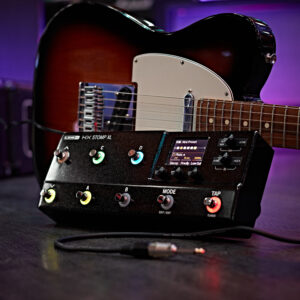
I went from the Variax, then I went to the Bogner amps, and the HD-500s with the pedalboards and the programmable amps. And now, of course, it’s Helix. For the last few years, the Helix is a fantastic tool. Since they coupled up with Yamaha, they’ve obviously had a new kind of level of perfectionism. But now I use Power Cabs and, for this tour, I’ll be using 2×12 Power Cabs. Yeah, I’m a die-hard.
Now, what it is about Line 6, I mean, Fenders are great and everything. But I’ve got to say the reliability and the ability for Line 6 amps to never sound like they’re under pressure. And I like that there’s always headroom in the sound, so I can give it a real punch and build in the processing sounds.
I feel like sometimes Fenders had a limit. While the Line 6 is just projection – sheer projection. And I don’t know whether people would disagree, but I’m not actually very loud on stage. I like a level that’s just right for my ears. I’m not trying to amplify the room- that’s the sound guy, the front of the house. I’m just trying to get my sound, I like that.
I thought “pedalboards, they’re so naff – bits of wood with stuff stuck on them”. I just wanted to go ‘tech’; you know?
G4M: I imagine a lot of musicians from the ‘70s and ‘80s will be analog purists and will refuse to move over to the modelling world. However, if it gets you from A to B, and you get the required sound, then whatever does the job, I assume that’s your opinion?
SH: What I like about it: since 2006/7, I would put a record on – say ‘Heat of the Moment’ (Asia) – and I get a guitar that I decide to play. Probably a Les Paul, or the ES-Artist, which is a guitar that’s got another whole story about it. That’s a guitar that Gibson brought out that I absolutely love and I’m still playing it.
It’s like a 335, or a 345. No F-holes, and it’s got active pickups – it’s great. I get that guitar, and with a guy called Steve Burnett that I do my programming with, basically, we try and duplicate the sound. Each song can have four different sounds with ease, so obviously they’ve got to be right. With the delays, the distortion; everything I want.
Having that option to duplicate records is vastly, vastly advanced from having a set of pedals. Call up the next sound, you’re straight there. You’ve got it straight away, you’re off, and you apply. So you don’t really have to think.
Ever since I started playing electric guitar, I’ve always had a volume pedal. I’ve always had something on the floor in front of me. Of course, that expanded to a wah wah, and a fuzz box, and the delay line, and all that kind of stuff – that’s so messy.
It’s all built into the Helix. My equipment is simpler than anybody else’s in Yes, I have the most streamlined system. Well: a helix, a power cab, and 10 guitars. Thank you, good night.
If I can use the actual guitar that I used on the recording, that obviously starts me off on the right foot. Sometimes you have to make compromises. Maybe you don’t want to take so many guitars, or you can’t change this one round – so I make compromises. But for the most part, I’ll use a guitar that’s the same or very similar.
G4M: I suppose if you’re not dancing with pedals all the time, you can focus more on each note you’re playing. The expressive side of it, and using the guitar as a tool of expression- which I get the impression you are wanting to lean into, with Yes, especially?
SH: Yeah, I mean, the notes were important. As Andre Previn found out, they’re supposed to be the right notes in the right order. The notes are one thing, but the texture and the treatment is just as important.
With the wrong sound, you’re kind of half-baked because you haven’t got the power, or the cleanness, or the delays – whatever it is. I’m completely sold on matching as close as I can to sounds that are recorded.
So, when I’m on stage, I’m not thinking about it at all. I’m going to just go to the first sound, the first effect I need on. Let’s say for example: “Does It Really Happen?”- I’m playing a Telecaster and it’s the right sound. I mean, that’s heaven.
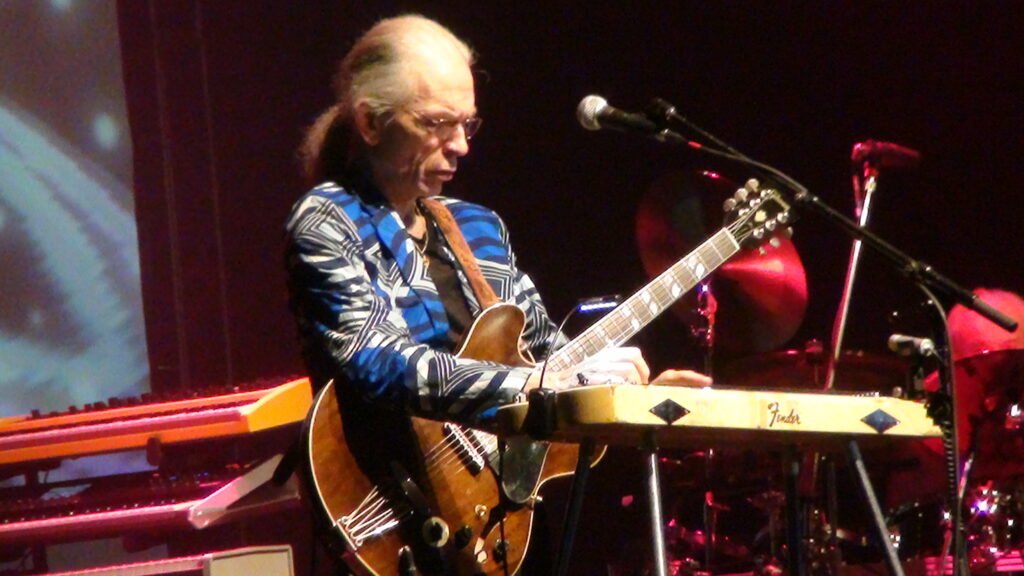
Creative Commons License by Clausgroi
G4M: I remember reading for the last Yes album – The Quest – that a lot of the guitar parts were recorded on a Line 6 Spider. Out of all the models even from Line 6, I wondered what it was that drew you to the Spider?
SH: Well, that isn’t strictly true. That’s a slight exaggeration because, in fact, I use a variety on all the records I use – it’s never one thing.
The convenient thing about them being built into my studio: it’s in the back of my control room, kind of blocked-in, and has a mic in front of it. The cable comes out here, and I plug it in, so it’s always set to go. Then I can go over and tweak the settings and find something like what I’m looking for, and then individualise it a little (take off some of the delays or add some more distortion or something).
But besides occasional DI guitars, I use something that’s totally underrated – the Boss GS-10. That is just a remarkable processer. And all the other stuff: GS-100, the Line 6 Pod XL Live – I’m spoilt for choice.
So again, that instinct is quite important. I’m not going to chase this sound around for three hours before I settle down. I’ve got to make a discerning choice on how I will get what I want in my head. Maybe this, maybe that. So that’s really what I do.
I’m glad that the amp’s had some promotion. It’s a nice standby amp that just sits there. And anytime I plug it in, I’m off, you know, with something that I can find.
The other thing, there’s a Gibson Explorer amp in my studio set up in a similar way, which is a 1960/61 or something. So there are amps I’ve had for years that I still like to use if I’m looking for something particularly warm and mellow. It really comes up to what’s needed, and I don’t mind what it is.
G4M: Final question: the 12 String acoustic on “And You and I” is one of the most iconic uses and I’ve been doing my best to dig and find out what guitar that was. The 12 string I’ve seen mentioned is a Martin J12-16. Do you know whether that was the acoustic guitar used on that recording?
SH: No, it wasn’t, I actually didn’t have that guitar yet. It was Chris Squires’ 12 string. I’m not sure the exact model, but it was a Guild. And it was a nice guitar.
At Advisian Studios, there were these guitars laying around. And when I picked that up, I thought, ‘’yeah, this is really nice’’. When we got to the ‘70s, of course, we were spoiled because Eddie Offord was the resident engineer in Advisian Studios. He had engineered the previous Yes record; I think it was either the Yes album or Fragile that we offered them a sort-of joint production credit.
I would credit him and his skill for understanding the level of technology that we had at the time. They understood these dodgy gadgets with knobs on the front with faders going metres – you had to get these right. And when you got it right, that 12 string guitar we talked about, the Guild, was given the treatment, if you like, by Eddie.
That was usually some UREI compressor limiters set how he liked them. And obviously, it does have a certain kind of depth of quality in the sound. So, you’ve got tape, you’ve got Eddie, and you’ve got a nice guitar. You’ve got a fairly good guitarist. Good ideas – I mean, that intro is his idea.
That simple idea sold the guys, and that was the way it was introduced. In fact, the strange thing is on “And You and I”, I worked it out one day that nearly 30% of it is me playing that 12 string on my own.
I think the “Roundabout” guitar, the (1953 Martin) 00-18 was actually recorded in the hall outside the studio for an ambience we wanted to get. But there was a room that didn’t have a video or you couldn’t see anything; I think that was quite often the room I used for the 12 string.
It was an isolated room, you know, a couple of high-quality mics. We’re talking THE mics of the era, which are now worth thousands of pounds. All the great UREIs, the great Sennheisers, oh just beautiful mics.
Eddie knew all about that. We were novices in comparison to Eddie’s recording skills, but he had a way of designing our sounds so that you could hear everybody. We believe he was the only guy in the world who knew how to make the busyness of Yes.
Chris was busy, I was pretty busy, the drums, and the keyboards, then the vocals and the counter vocals. He was the only guy I’d still say, who understood how to get those all to figure because up until then, usually there were front sounds and there were back sounds.
But in Yes, everything was front. Everything was in your face. Everything was detailed so that it was focused and you could hear it.
Eddie really is an unsung hero. A bit like Roger Dean is for our artwork. But people see the artwork, so they know Roger is doing our artwork, and he’s brilliant. But what they forget is that, up until and including Relayer, all those early albums were co-produced by Eddie. He gave us an awful lot of confidence because he took care of the busyness.
I think the “Roundabout” guitar, the (1953 Martin) 00-18 was actually recorded in the hall outside the studio for an ambience we wanted to get.
If this insight has piqued your interest and you want to experience the tones mentioned here for yourself, you can catch Yes at various tour dates throughout the UK in June:
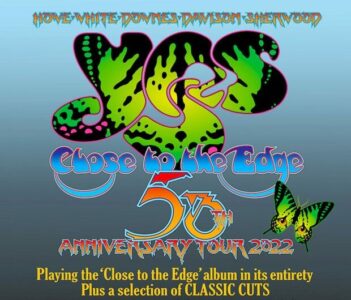
- Wednesday, 15 June 2022 – Royal Concert Hall – Glasgow, UK
- Friday, 17 June 2022 -Bridgewater Hall – Manchester, UK
- Saturday, 18 June 2022 – Royal concert Hall – Nottingham, UK
- Monday, 20 June 2022 – Philharmonic Hall – Liverpool, UK
- Tuesday, 21 June 2022 – Royal Albert Hall – London, UK
- Wednesday, 22 June 2022 – Barbican – York, UK
- Friday, 24 June 2022 – Symphony Hall – Birmingham, UK
- Sunday, 26 June 2022 – City Hall – Newcastle, UK
- Tuesday 28 June, 2022 – Vicar Street – Dublin, Ireland
- Wednesday 29 June, 2022 – Cork Opera House – Cork, Ireland

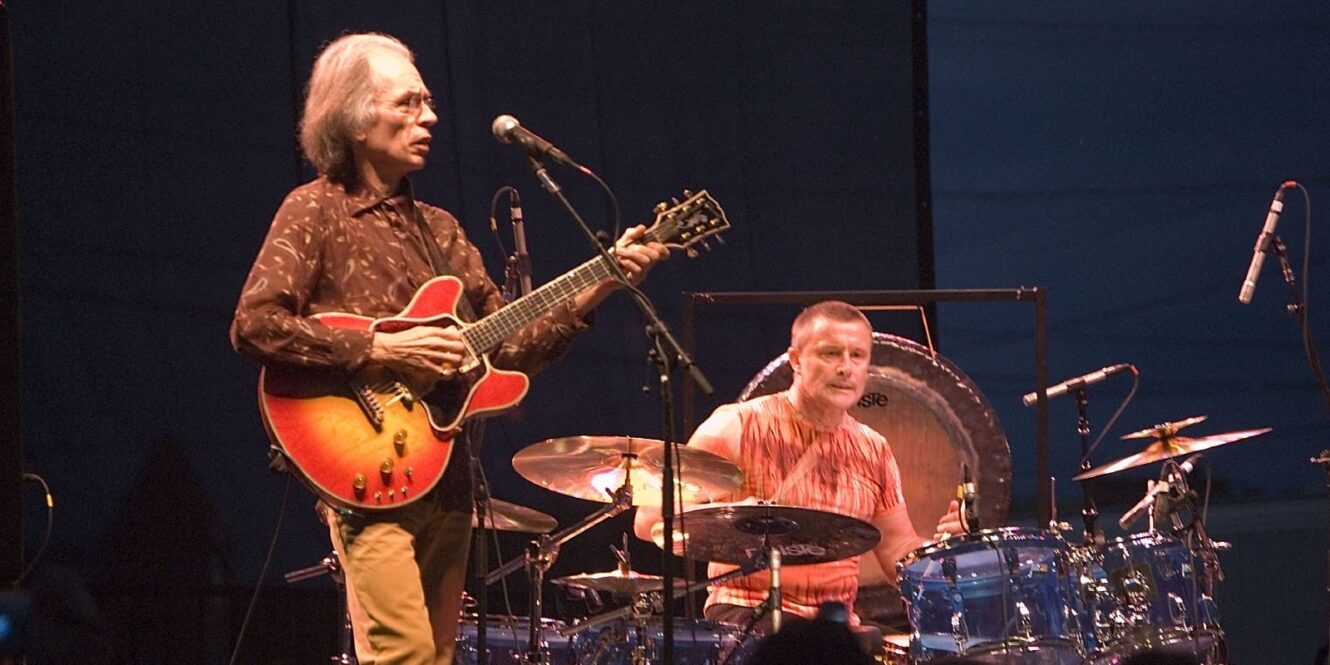











0 Comments